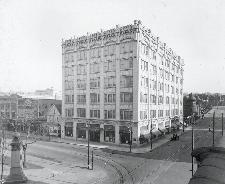Exhibit Shows Work of Architect Who Helped to “Build Scranton”

For Immediate Release
Exhibit Shows Work of Architect Who Helped to “Build Scranton”
The University of Scranton’s Hope Horn Gallery at Hyland Hall will exhibit the work of George M.D. Lewis, the architect who shaped the face of Scranton as we know it, beginning Friday, Mar. 6, with a lecture by Josephine M. Dunn, Ph.D., associate professor of art history at Scranton.
Driving off the Central Scranton Expressway onto Spruce Street, motorists cannot ignore the architecture Scranton presents before them: the Scranton Gas & Water Company, the Stoehr and Fister building (now the Courthouse Annex), the Bank Towers building and the Scranton Times building.
All these buildings, and several more, have at least one thing in common: George M.D. Lewis designed them in an effort that transformed Scranton from Romanesque to Classical, ushering in a 20th century style in architecture.
“You could accurately say that the architectural firm of Davis and Lewis changed the face of Scranton in the 1920’s and 30’s,” Dr. Dunn said.
The exhibit in the Hope Horn Gallery will feature original drawings of Davis and Lewis’ buildings and photographs of the completed structures by John Horgan Jr., a photographer known for his work documenting Pennsylvania’s anthracite industry.
Another interesting piece in the exhibit is Lewis’ sketch for the Masonic Temple, now the Scranton Cultural Center. Lewis did not earn that commission, though his vision for it was realized on paper and is included in the exhibit.
A graduate of Technical High School in 1910, Lewis went on to pursue his degree in architecture at the University of Pennsylvania, thanks to a loan his then-boss and later-partner, Edward Davis, gave the young and ambitious Lewis. After graduating with his bachelor’s degree in 1916, Lewis went on to earn a master’s degree from Penn, but World War I called him into service before he had a chance to don his cap and gown for the second time.
Instead, his mother slipped them on and participated in the commencement ceremony in his place while Lewis sailed to Italy, where he became the first pilot to fly over the Alps.
Upon returning to Scranton in January 1919, Lewis went back to work with Davis to do his part in advancing the city to greatness.
The lecture and exhibit are both free and open to the public. The lecture will begin at 5 p.m. on Mar. 6 in Brennan Hall’s Pearn Auditorium. Following the lecture, an opening reception for “Classical Scranton: The Architecture of Davis and Lewis 1920-1943” will be held at the Hope Horn Gallery in Hyland Hall from 6 p.m. to 8 p.m.
The exhibit will be on display at the Hope Horn Gallery until Apr. 3.
For additional information contact Darlene A. Miller-Lanning, Ph.D., director of the Hope Horn Gallery, at 941-4214.






